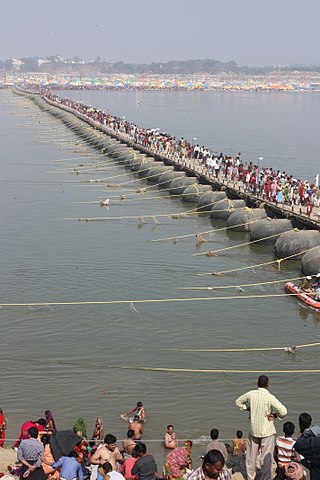
Kumbh Mela or Kumbha Mela is a major pilgrimage and festival in Hinduism, On February 4, 2019, Kumbh Mela witnessed the largest public gathering. It is celebrated in a cycle of approximately 12 years, to celebrate every revolution Brihaspati (Jupiter) completes, at four river-bank pilgrimage sites: Prayagraj, Haridwar (Ganges), Nashik (Godavari), and Ujjain (Shipra). The festival is marked by a ritual dip in the waters, but it is also a celebration of community commerce with numerous fairs, education, religious discourses by saints, mass gatherings of monks, and entertainment. The seekers believe that bathing in these rivers is a means to prāyaścitta for past mistakes, and that it cleanses them of their sins.

Kurukshetra is a city and administrative headquarters of Kurukshetra district in the Indian state of Haryana. It is also known as Dharmakshetra and as the "Land of the Bhagavad Gita".

Pushkar Lake or Pushkar Sarovar is located in the town of Pushkar near Ajmer city in Ajmer district of the Rajasthan state of western India. Pushkar Lake is a sacred lake of the Hindus. The Hindu scriptures describe it as "Tirtha-Guru" [Thirtha Raj]– the perceptor of pilgrimage sites related to a water-body and relate it to the mythology of the creator-god Brahma, whose most prominent temple stands in Pushkar. The Pushkar Lake finds mention on coins as early as the 4th century BC.
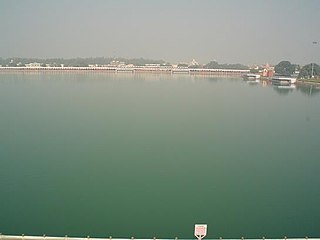
Brahma Sarovar is a man-made tank in Kurukshetra, in the state of Haryana, India. It is 3600 feet long, 1500 feet wide, and 45 feet deep. Hinduism lays emphasis on taking bath for internal and external purity. Most religious sites have water pools or sarovar in or near the Hindu temple and Sikh gurdwara. The Hindu genealogy registers at Kurukshetra, Haryana are kept here.
The following list consists of notable concepts that are derived from Hindu culture and associated cultures’ traditions, which are expressed as words in Sanskrit or other Indic languages and Dravidian languages. The main purpose of this list is to disambiguate multiple spellings, to make note of spellings no longer in use for these concepts, to define the concept in one or two lines, to make it easy for one to find and pin down specific concepts, and to provide a guide to unique concepts of Hinduism all in one place.

Gita Mahotsav,Gita Jayanti, also known as Mokshada Ekadashi or Matsya Dvadashi is a Hindu observance that marks the day the Bhagavad Gita dialogue occurred between Arjuna and Krishna on the battlefield of Kurukshetra. It is celebrated on Shukla Ekadashi, the 11th day of the waxing moon of the lunar month Margashirsha (December–January) of the Hindu calendar.

Parikrama or Pradakshina is clockwise circumambulation of sacred entities, and the path along which this is performed, as practiced in the Indic religions – Hinduism, Buddhism, Sikhism and Jainism. In Buddhism, it refers only to the path along which this is performed. Typically, in Indic-religions the parikrama is done after completion of traditional worship and after paying homage to the deity. Parikrama must be done with dhyāna.
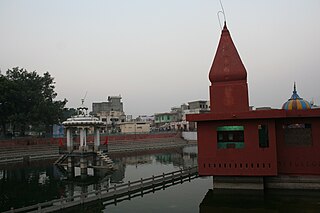
Pehowa is a town and a municipal committee in Kurukshetra district in the Indian state of Haryana. It is an important sacred Hindu pilgrimage site, related to Krishna and Mahabharata, within the 48 Kos Parikrama of Kurukshetra. The Hindu genealogy registers at Peohwa, Haryana are kept here at the Pruthudak Tirath on the banks of Sarasvati river.
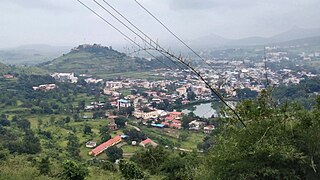
Trimbak is a city and a municipal council in Nashik District in the Indian state of Maharashtra. The Trimbakeshwar Shiva Temple is located here, one of the twelve Jyotirlingas, where the Hindu genealogy registers at Trimbakeshwar, Maharashtra are kept. The origin of the sacred Godavari River is near Trimbak.

Jyotisar, on the bank of Jyotisar Sarovar wetland, is a Hindu pilgrimage site in the city of Kurukshetra in Haryana state of India. According to Hindu tradition, Krishna delivered the sermon of Bhagavad Gita - the doctrine of Karma and Dharma to his wavering friend Arjuna to guide him to resolve his ethical dilemma and revealed his vishvarupa to him.
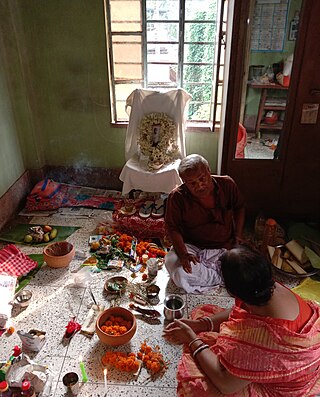
Śrāddha, is the ritual that one performs to pay homage to one's pitṛs, especially to one's dead parents. Conceptually, it is a way for people to express their heartfelt gratitude and thanks towards their parents and ancestors, for having helped them to be what they are and praying for their peace. It also can be thought of as a "day of remembrance". It is performed for both the father and mother separately, on their respective date ('tithi') of death as per the Hindu Calendar. In addition it is also performed for the entire community of 'pitr' – both from paternal and maternal side – collectively during the Pitri Paksha or Shraaddha paksha, right before Sharad Navaratri in autumn.

In Hinduism, the yatra (pilgrimage) to the tirthas has special significance for earning the punya needed to attain the moksha (salvation) by performing the darśana, the parikrama (circumambulation), the yajna, the Dhyana, the puja (worship), the prarthana, the dakshina, the seva, the bhandara, etc. These sacred places are usually located on the banks of sacred waters, such as sacred rivers or their tributaries, the kundas, the ghats, or the stepwells, or the temple tanks.

Dhosi Hill is an important Vedic period site, an extinct volcano, standing alone at the north-west end of the Aravalli mountain range. Its height varies from about 345 to 470 meters from the surrounding lands and 740 meters from the sea level. At present the hill has temples, a pakka pond, ruins of a fort, caves and forest around it. In the ancient times, as per various scriptures like Mahabharata - Vanparv, Puranas, Shathpath Brahmana etc. the hill had Ashrams of various Rishis who made contributions to Vedic scriptures.

Yatra, in Indian-origin religions, Hinduism, Buddhism, Jainism and Sikhism, generally means a pilgrimage to holy places such as confluences of sacred rivers, sacred mountains, places associated with Hindu epics such as the Mahabharata and Ramayana, and other sacred pilgrimage sites. Visiting a sacred place is believed by the pilgrim to purify the self and bring one closer to the divine. The journey itself is as important as the destination, and the hardships of travel serve as an act of devotion in themselves.
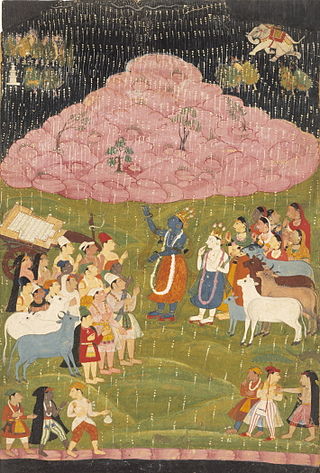
The Govardhana Shila is a rock from the Govardhana Hill in Braj, Uttar Pradesh, India. Govardhan Hill holds a unique position in Hindu scriptures related to Krishna, the land called Braj where He was born. Known as Govardhan or Giriraj and being the sacred centre of Braj, it is identified as a natural form of Krishna. Indian art overwhelmingly prefers the iconic image, but some aniconism does occur in folk worship, early Buddhism, Shiva's Banalinga, and Vishnu's Shaligrama). They have solar significance, and their use in worship predates the Hindu period in India. The stone is usually brown in colour.
Abhimanyupur is a village in Kurukshetra district of Haryana, India. This village is 8 kilometres from the city of Kurukshetra. This village is famous for being the site where Abhimanyu, the son of Arjuna, died in the Mahabharata War. This is the site where the Kauravas arranged the deadly "chakravyuha" formation and trapped and killed Abhimanyu. This village is part of the 48 kos parikrama of Kurukshetra. This village has many sacred places associated with Hinduism.
Narasimha Temple is situated in Puri, Odisha, India, to the western side of Gundicha Temple and to the east of the Indradyumna tank.

Narayan Sarovar or Narayansar is a village and place of pilgrimage for Hindus on the Kori Creek. It is located in Lakhpat taluka of Kutch district in the Indian state of Gujarat. The ancient Koteshwar temple lies 4 km away, towards the north-west. The temple is classified among the 108 Abhimana Kshethram of Vaishnavate tradition.

The 48 kos parikrama is a parikrama of various Mahabharata-related and other Vedic-era tirthas around the holy city of Kurukshetra in the state of Haryana, India.

Kidangoor Subramanya Swami Temple is an ancient Hindu temple located in Kidangoor near Ayarkkunnam in Kottayam district in the Indian state of Kerala. It is one of the renowned Subramanya temples in Kerala which is estimated to be at least 1500 years old.


















